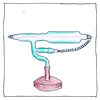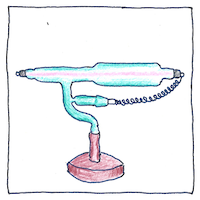Johann Wilhelm Hittorf
electromagnetism

|
Cathode ray
The cathode of a vacuum tube under high voltage emits a stream of negatively charged particles that makes the glass on the opposite side fluoresce. Johann Wilhelm Hittorf found that cathode rays glowed different colours for different gases under different pressures in the tube. He also found that cathode rays cast the shadow of an object between the cathode and the illuminating side of the tube.
Electron energy
The speed of an electron depends on the voltage. The electric charge of an electron is constant, so if you pep it up, it can express its energy only kinetically.
Mysterious rays
Mysterious rays emanate from space and pass through our bodies lickety split. Dark matter, dark energy. If it were only visible we would know more about it, but then it would not be what it is. UFOs may radiate unidentified rays or they may reflect gravity waves for levitation. Nanowaves, smaller than microwaves, have practical uses, such as cleaning teeth and visualizing processes on the atomic scale. Quantum rays may entangle the states of particles or prevent separate particles from sharing the same state. Mysterious rays, yet undiscovered, could either heal or harm all life-forms. Hummingbirds and bugs may see things that we only wish we knew about.



At the time, Hittorf and other scientists did not know about electrons or the composition of atoms. The discovery of the cathode ray was an important step toward understanding our universe.
Although we understand the electromagnetic spectrum, which describes the range and limits of the behavior of photons, we have yet to fully pry apart and control all particles. Like photons, particles may travel. Hence travelling electrons, neutrinos, and ions. Hence electron and ion guns and particle accelerators.
See also in The book of science:
Readings in wikipedia: